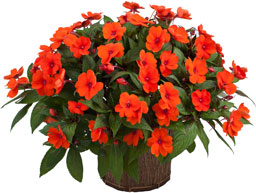8/28/2013
Sun-Loving Sun Harmony: The Ideal Impatiens for Gardens & Pots
Chanochi Zaks
Who says impatiens aren’t for full sun? Danziger’s sun- and heat-tolerant Sun Harmony New Guinea Impatiens series just keeps growing, featuring a palette of colors guaranteed to brighten any setting—whether in the strongest sun or milder partial shade locations.
Even at the peak of summer, the plants remain covered in flowers. All of the varieties in the series feature highly branched, mounded, compact habits. Large, 2-in. rounded flowers are held above medium green leaves.
Blooming profusely and continuously from early spring through fall, Sun Harmony varieties offer excellent garden performance in full sunlight or partial shade.
Plants grow 16 to 20 in. tall in the garden and their thick, succulent stems and sturdy habit make them a durable favorite.
Testing in a variety of climates and conditions continues successfully, with the Sun Harmony series receiving a number of top awards and recognitions.
Colors in the series currently include Deep Orange, Magenta, Orange, Pink, Purple, Salmon and Violet. Future plans include new colors, such as a red and a white, as well as stunning bicolor options.
Rooting
Root for 2 to 3 weeks at temperatures of 72 to 75F (22 to 24C) in a well-drained, light peat medium. Electrical conductivity (EC) should be 0.6 to 0.9, while pH should be 5.5 to 6.0.
Keep soil moderately dry to prevent lack of aeration, which can cause chlorotic foliage. Fertilize at 75 to 100 ppm and keep light intensity high. Transplant in about 21 days.
Planting
For a spring finish, plant from January to March. For 5- to 6-in. (13- to 15-cm) pots, use 1 plant per pot. Plants will be ready for sale in 8 to 10 weeks. For 10-in. (25-cm) hanging baskets or pots, use 3 plants per pot, and plants will be ready in 8 to 10 weeks.
Light
Sun Harmony varieties prefer full sunlight to partial shade.
Temperature
Provide daytime temperatures of 68 to 72F (20 to 22C) and keep nighttime temperatures at between 68 and 70F (20 to 21C). Low temperatures may result in plants that are too compact, while high temperatures on the other hand may cause stem elongation. Sun Harmony can be grown cooler, but time will need to be added to the crop.
Fertilization
Fertilize at low levels for the first four weeks. For the remaining crop cycle, continue at moderate levels. Once roots reach the sides of the pot, fertilize with 75 to 100 ppm nitrogen. Because Sun Harmony can have sensitivity to high salt levels, prevent salt accumulation by providing proper runoff.
 Irrigation
Irrigation
Avoid over watering. Keep plants evenly moist.
Medium
Use a disease-free, well-drained mix. Maintain electrical conductivity (EC) at 0.5 to 0.7 and pH at 5.8 to 6.2.
Pinching and plant growth regulators
Pinching isn’t necessary when growing Sun Harmony. PGRs may be needed in production. Bonzi or Sumagic are effective at low rates to control unwanted growth. Always refer to labeled instructions when using these PGRs.
Disease and insect control
Monitor and scout vigilantly to prevent disease or insect activity. Monitor carefully for insects including broad mites and thrips. Watch closely for diseases including botrytis and myrothecium.
Maintain a preventive program that includes good air circulation and moderate humidity levels. At liner planting, drench with a broad-spectrum fungicide.
For more information on Sun Harmony or any of Danziger’s products email
danziger@danziger.co.il or visit
www.danziger.co.il.
GT
Chanochi Zaks is vice president of marketing for Danziger “Dan” Flower Farm. He can be reached at chanochi@danziger.co.il.